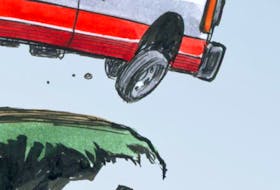Dear editor: I read your front-page article on the sewage problem in The Western Star of 31st October with interest, and some dismay. Sewage and smells: How can a problem like this not be diagnosed and resolved in 2017?
For many years I drove through Irishtown on my way to my clinic in Meadows. In the early years (late 1960s and through the 1970s) there was raw sewage in the ditches alongside the road.
Then the government recognized the problem, and realized the potential for possibly serious health effects in the communities along the North Shore of the Bay of Islands, and water and sewage projects appeared every summer. It appeared to some of us that communication between government departments was missing, as the road was newly paved shortly before it was soon ripped open for water and sewage projects. This happened on more than one occasion.
But surely 50 years later we have more effective monitoring and management of these problems? Yes we do!
Surely there is better communication between departments of government? So why is this problem now festering in Irishtown?
There are obviously many reasons and factors in play here. But I suggest that this problem should not have persisted for such a long time.
Firstly, there are regulations. They can be found at Service NL. They are detailed and specifically refer to the details of the drainage field, and the type of soil in the field. Forty years ago a friend of mine had to dig out a large area of his proposed drainage field and backfill it with gravel. This was required by law for health and safety reasons. The heavy clay would have caused a problem in absorption of the effluent, which would have leaked into a drainage ditch.
Forty years ago there had to be inspections and documentation of all the stages of the septic system: I still have copies of mine. Surely there should be records somewhere of this septic system?
Or if not, then there is reason to suspect that the system is a very old one; in which case one may suppose that some of the underground structures, septic tank, distribution box, or the distribution lines are broken.
I do not think that a single dye test is enough to assess the integrity of this system.
If performed at a time of day when there was little activity in the home there would be little flow leaching out. If performed during the dry warm summer season, the dry soil would absorb more leachate than in the rest of the year.
Bacteriological assessment of the area indicated in the photo should be performed looking for coliform bacteria.
But irrespective of all this, surely the Department of Municipal Affairs, Department of Health, and the municipality of Summerside-Irishtown should co-operate and end this nuisance.
The chemical reactions in the septic tank are made by anaerobic bacteria; that is in the absence of air and oxygen. This decomposing creates the bad smell.
However in the dispersal field, and the distribution field, the chemical breakdown is by aerobic bacteria, using the oxygen in sandy or gravelly soil, and absent in heavy pug or clay.
This may be a clue as to where the drainage fault may lie in this case.
Dr. Ian Simpson, Humber Village

![['WS-xx-letter to the editor']](https://saltwire.imgix.net/letter-to-the-editor-2828734.jpg?cs=srgb&fit=crop&h=568&w=847&dpr=1&auto=enhance%2Ccompress%2Cformat)







